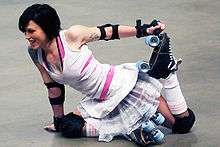Stretching

Stretching is a form of physical exercise in which a specific muscle or tendon (or muscle group) is deliberately flexed or stretched in order to improve the muscle's felt elasticity and achieve comfortable muscle tone.[1] The result is a feeling of increased muscle control, flexibility, and range of motion. Stretching is also used therapeutically to alleviate cramps.[2]
In its most basic form, stretching is a natural and instinctive activity; it is performed by humans and many other animals. It can be accompanied by yawning. Stretching often occurs instinctively after waking from sleep, after long periods of inactivity, or after exiting confined spaces and areas.
Increasing flexibility through stretching is one of the basic tenets of physical fitness. It is common for athletes to stretch before (for warming up) and after exercise in an attempt to reduce risk of injury and increase performance,[3] though these practices are not always based on scientific evidence of effectiveness.
Stretching can be dangerous when performed incorrectly. There are many techniques for stretching in general, but depending on which muscle group is being stretched, some techniques may be ineffective or detrimental, even to the point of causing hypermobility, instability, or permanent damage to the tendons, ligaments, and muscle fiber.[4] The physiological nature of stretching and theories about the effect of various techniques are therefore subject to heavy inquiry.
Although static stretching (see image on the right for an example) is part of some warm-up routines, a study in 2013 indicated that it weakens muscles. For this reason, dynamic stretching is recommended before exercise in place of static stretching, while the latter helps to reduce muscle soreness afterwards.[5]
Physiology
Studies have shed light on the function, in stretching, of a large protein within the myofibrils of skeletal muscles named titin.[6] A study performed by Magid and Law demonstrated that the origin of passive muscle tension (which occurs during stretching) is actually within the myofibrils, not extracellularly as had previously been supposed.[7] Due to neurological safeguards against injury, it is normally impossible for adults to stretch most muscle groups to their fullest length without training due to the activation of muscle antagonists as the muscle reaches the limit of its normal range of motion.[4]
Types of stretches
.jpg)
There are five different types of stretching: ballistic, dynamic, SMF stretching, PNF stretching, and static stretching. Ballistic stretching is a rapid bouncing stretch in which a body part is moving with momentum that stretches the muscles to a maximum. Muscles respond to this type of stretching by contracting to protect itself from over extending. Dynamic stretching is a walking or movement stretch. By performing slow controlled movements through full range of motion, a person reduces risk of injury. Proprioceptive neuromuscular facilitation (PNF) is a type of stretch for a particular muscle and its specific job, so resistance should be applied, then the muscle should be relaxed. Static stretching is a type of stretch whereby a person stretches the muscle until a gentle tension is felt and then holds the stretch for thirty seconds or until a muscle release is felt, without any movement or bouncing.[3]
Effectiveness

Although many people engage in stretching before or after exercise, the medical evidence has shown this has no meaningful benefit in preventing muscle soreness.[8]
Stretching does not appear to reduce the risk of injury during exercise, except perhaps for runners.[9] There is some evidence that pre-exercise stretching may increase athletes' range of movement.[9][10]
The Mayo Clinic advises against bouncing in stretches, and to hold them for thirty seconds. To prevent injury, they suggest warming up before stretching or stretching after exercise instead.[11]
References
- ↑ Weerapong, Pornratshanee; Hume, Patria A.; Kolt, Gregory S. (2004). "Stretching: Mechanisms and Benefits for Sports Performance and Injury Prevention". Physical Therapy Reviews. 9 (4): 189–206. doi:10.1179/108331904225007078.
- ↑ Dagenais, Marc (December 2011) Softball Training Tips – Do you know how to stretch? softballperformance.com
- 1 2 Prentice, William E. (2003) Principles of Athletic Training, McGraw Hill, ISBN 0071092552.
- 1 2 Tsatsouline, Pavel (2001). Relax into stretch: instant flexibility through mastering muscle tension. Dragon Door Publications. ISBN 978-0-938045-28-1.
- ↑ Reasons Not to Stretch New York Times, 2013-04-03.
- ↑ Molecular origin of the hierarchical elasticity of titin: simulation, experiment and theory. Jen Hsin, Johan Strümpfer, Eric H. Lee, and Klaus Schulten. Annual Review of Biophysics, 40:187-203, 2011.
- ↑ University of California Regents > Muscle Physiology – Types of Contractions. muscle.ucsd.edu
- ↑ Herbert RD, de Noronha M, Kamper SJ (2011). "Stretching to prevent or reduce muscle soreness after exercise". Cochrane Database Syst Rev (Systematic review) (7): CD004577. doi:10.1002/14651858.CD004577.pub3. PMID 21735398.
- 1 2 Behm DG, Blazevich AJ, Kay AD, McHugh M (2016). "Acute effects of muscle stretching on physical performance, range of motion, and injury incidence in healthy active individuals: a systematic review". Appl Physiol Nutr Metab (Systematic review). 41 (1): 1–11. doi:10.1139/apnm-2015-0235. PMID 26642915.
- ↑ Page P (2012). "Current concepts in muscle stretching for exercise and rehabilitation". International Journal of Sports Physical Therapy. 7: 109–19. PMC 3273886. PMID 22319684.
- ↑ "Stretching is not a warm up! Find out why".
Further reading
- Andersen JC (2005). "Stretching Before and After Exercise: Effect on Muscle Soreness and Injury Risk". Journal of Athletic Training. 40: 218–220.
- Anderson, Bob. "Stretching: 30th Anniversary Edition". Shelter Publications (2010)
- Cheung Karoline, Hume Patria A., Maxwell Linda (2003). "Delayed Onset Muscle Soreness: Treatment Strategies and Performance Factors". Sports Medicine. 33 (2): 145–164. doi:10.2165/00007256-200333020-00005. PMID 12617692.
- LaRoche D, Connolly DAJ (2006). "Effects of Stretching on Passive Muscle Tension and Response to Eccentric Exercise". American Journal of Sports Medicine. 34 (6): 1000–1007. doi:10.1177/0363546505284238.
- Shrier, Ian. "When and Whom to Stretch?" Physician & Sportsmedicine 33.3(2005): 22–26.
| Wikimedia Commons has media related to Stretching. |